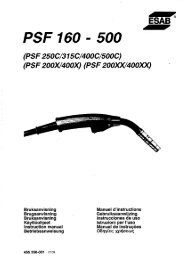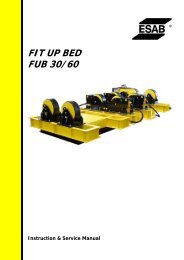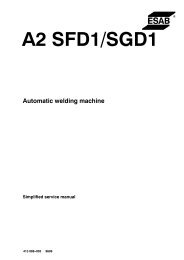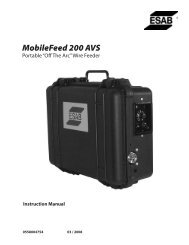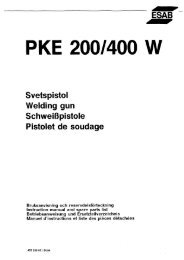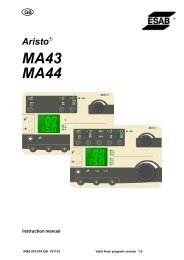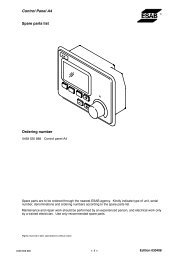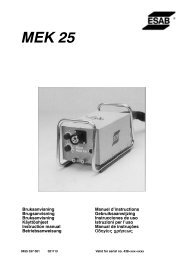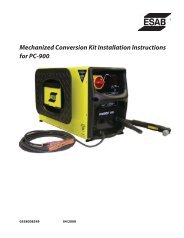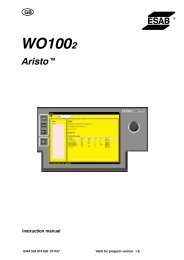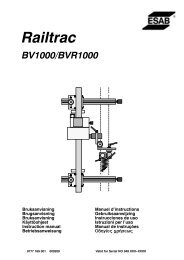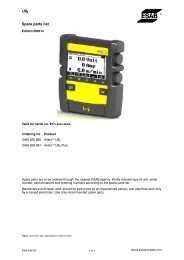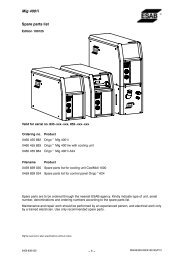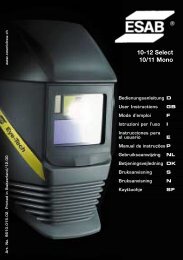You also want an ePaper? Increase the reach of your titles
YUMPU automatically turns print PDFs into web optimized ePapers that Google loves.
Figure 3 // Modules from Thailand arriving at the Aibel<br />
yard in Haugesund.<br />
Origo Mig 40<strong>01</strong>i inverter with<br />
Origo YardFeed 2000 winner at Aibel<br />
Aibel put four machines from four different suppliers to<br />
the test in a two-month investigation involving 13 of their<br />
best welders. To get a good view on their performance,<br />
the power sources were used in actual production along<br />
with existing welding equipment and with the same<br />
welding consumables.<br />
One of the machines from another supplier was soon<br />
taken out of the test, because of its unstable wire burn-off<br />
in FCAW which was regarded to be a potential cause<br />
of welding defects. This required very precise parameter<br />
settings and could, nevertheless, not be solved<br />
satisfactorily. An aspect of this machine which the<br />
welders really disliked was the switch on the door of the<br />
wire feeder that needed to be activated to allow welding.<br />
A second machine did not have the required voltage<br />
display on the wire feeder needed by the welder to set<br />
the welding parameters. <strong>The</strong> supplier was asked to<br />
change this, but they failed to come up with a solution.<br />
<strong>The</strong> machine had otherwise good welding characteristics.<br />
Real competition took place between <strong>ESAB</strong> and the<br />
supplier of many of the MMA/FCAW power sources<br />
used by the yard at that moment. <strong>The</strong> latter has a solid<br />
reputation among welders at Aibel, while <strong>ESAB</strong> is<br />
respected for its automated TIG, plasma, and subarc<br />
solutions and for its excellent welding consumables.<br />
Odds were even in this respect, so the decision had to<br />
come from a comparison on design and performance<br />
of the machines.<br />
<strong>ESAB</strong>’s Origo Mig 40<strong>01</strong>i with Origo YardFeed 2000 and<br />
power source number three are comparable equipment<br />
and both suited for heavy duty offshore fabrication.<br />
Both feature primary switching inverter technology,<br />
separate wire feeders, and good welding characteristics.<br />
Differences are minor, but yet big enough to make Aibel<br />
decide in favour of <strong>ESAB</strong>.<br />
Most important was the minor amount of error codes<br />
generated by Origo Mig 40<strong>01</strong>i with Origo YardFeed 2000<br />
and reported by the welders. Error codes result in a<br />
lower duty cycle and loss of productivity. This, in<br />
combination with a display panel of power source number<br />
three that had to be changed and repaired two times, was<br />
one of the main reasons to finally opt for the <strong>ESAB</strong><br />
solution which performed without any problems. Another<br />
decisive factor was the lower weight of the Origo<br />
YardFeed 2000 of 11.3 kg versus 13.6 kg for the feeder of<br />
supplier number three. Also there was more space around<br />
the 5 kg wire spool, making it easier to replace. <strong>The</strong> ability<br />
to activate three different parameter settings from the<br />
welding gun was another well appreciated feature that<br />
helped <strong>ESAB</strong> win the contest.<br />
A real workhorse for heavy duty<br />
fabrication<br />
At 40 kg for the Origo Mig 40<strong>01</strong>i power source and<br />
11 kg for Origo YardFeed 2000, the equipment can be<br />
categorised as low weight. Weight increases by 14 kg<br />
with the water-cooled version (Origo Mig 40<strong>01</strong>iw) and<br />
another 19 kg for the cooling agent. Yet the equipment<br />
is robust and built for heavy industries such as<br />
shipbuilding and offshore fabrication – durable and<br />
dependable. In total, Aibel ordered 10 air-cooled and 20<br />
water-cooled versions with MA23 panels mounted on<br />
the wire feeder.<br />
Figure 4 // MA23 – <strong>ESAB</strong>’s basic panel for MMA, FCAW<br />
and MIG/MAG.<br />
MA23 is the most basic panel, giving MMA, FCAW, and<br />
MIG/MAG short and spray arc are generally applied in<br />
welding main offshore structures with stick electrodes and<br />
cored wires respectively. <strong>The</strong> panel enables CC/CV power<br />
source characteristics, has a digital V/A meter, 2- and<br />
4-stroke, step-less inductance setting, gas purge and wire<br />
inching, remote control, and three memory positions for<br />
parameter settings. It meets most of Aibel’s requirements<br />
in terms of welding processes and functionality. More<br />
advanced features like pulsing, QSet, and synergic lines<br />
are not available with the MA23 panel and are not<br />
necessary in this type of heavy wall thickness welding.<br />
<strong>The</strong>re is always the possibility to later upgrade the<br />
machines with the more advanced MA24 panel, for<br />
instance to enable the welding of stainless and nickelbase<br />
materials.<br />
<strong>The</strong> panel is mounted on the Origo YardFeed 2000 wire<br />
feeder, so that the welder can do all necessary settings<br />
at the welding site. A remote control for regulation at the<br />
arc is optional, but Aibel decided it was not necessary to<br />
purchase any. <strong>ESAB</strong> offers connection cables from 10 m<br />
to 50 m in length enabling a corresponding working<br />
radius (plus gun hose assembly) of the power source.<br />
Longer cables, however, mean more weight for the welder<br />
to carry. With low weight being the major requirement,<br />
Aibel opted for the shortest length of 10 m, accepting the<br />
limited working radius.<br />
FILARC PZ6138 cored wire still<br />
going strong<br />
Introduced in the mid-eighties, the FILARC PZ6138 all<br />
positional rutile cored wire is still the benchmark product<br />
in offshore fabrication combining a number of unique<br />
properties. Amongst others, the Norwegian offshore<br />
industry called for the development of a low-hydrogen<br />
cored wire with excellent weldability for the productive<br />
joining of low-temperature steel. <strong>The</strong> outcome, at the time,<br />
was sensational.<br />
Used in Ar/CO 2 shielding gas, the rutile based slag<br />
formulation provides welding properties that were not<br />
seen before with cored wires. PZ6138 has a soft spatterfree<br />
arc that always operates in the spray arc mode with a<br />
good penetration and good wetting onto the plate edges.<br />
It is extremely “welder-friendly” which makes it easier for<br />
the welder to produce sound welds. <strong>The</strong> availability of all<br />
positional rutile cored wires, such as PZ6138, helped the<br />
offshore industry in combating typical positional welding<br />
defects such as lack of fusion and slag inclusions.<br />
Another aspect much needed by the offshore<br />
industry was the very high productivity of PZ6138 in<br />
manual positional welding – up to three times as fast as<br />
commonly used stick electrodes. This, in combination<br />
with excellent low-temperature CVN (-60°C) and CTOD<br />
(-15°C) mechanical properties and low-hydrogen weld<br />
metal over the full parameter envelope, soon made this<br />
cored wire the most popular welding consumable in<br />
North Sea offshore fabrication. Nowadays, the wire is also<br />
widely applied in new offshore fabrication areas in the<br />
Middle East and Far East and in Brazil. Later introduced<br />
and based on PZ6138 are PZ6138 SR (stress relieving)<br />
and PZ6138S SR (CO 2 shielding gas + stress relieving).<br />
<strong>The</strong> fabrication of the Gudrun platform is proof that<br />
FILARC PZ6138 is still going strong in offshore<br />
fabrication. It is widely applied in primary construction,<br />
among others, for welding the super critical box nodes<br />
connecting the several stories of the deck.<br />
Figure 5 // FILARC PZ6138SR all positional rutile<br />
cored wire.<br />
Figure 6 // Spectacular view on the welding of one of the<br />
box nodes of the Gudrun platform. <strong>The</strong> lightweight Origo<br />
YardFeed 2000 wire feeder with 5 kg cored wire spool is<br />
easily hand carried to the welding site.<br />
Figure 6 shows the actual welding of one of the box<br />
nodes with PZ6138 all positional rutile cored wire.<br />
<strong>The</strong> lightweight Origo YardFeed 2000 wire feeder is<br />
carried to the welding site and positioned within reach of<br />
the welder. Welding parameters are set and fine-tuned<br />
with the MA23 panel on the feeder.<br />
FEATURED PRODUCTS<br />
n Origo Mig 40<strong>01</strong>i multi-process inverter-<br />
powered welding equipment, designed for<br />
welding construction and stainless steel<br />
with Origo YardFeed 2000, digital wire feeder<br />
with working radius up to 50 m.<br />
n FILARC PZ6138 all positional cored wire.<br />
Well established in the offshore sector and<br />
other demanding constructions like pressure<br />
vessels, etc. An impact property down to<br />
-60°C and it is CTOD-tested at -10°C.<br />
5 // FEATURE FEATURE // 6



